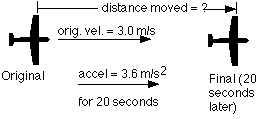BHS
-> Staff
-> Mr. Stanbrough ->
Physics -> Mechanics
-> Kinematics -> ![]() ->
this page
->
this page
An airplane, initially moving at 3.0 m/s down a runway, begins to accelerate down the runway at 3.6 m/s2. How far down the runway will it be in 20 seconds?

vo = 3.0 m/s
a = 3.6 m/s2
= 20 s
= ?
The plan: We can use
to find the distance the plane moves - except that we don't know the plane's average velocity,
. We could find the plane's average velocity using the equation
, except we don't know the airplane's final velocity, v. Well, we could find the plane's final velocity from the equation
. Ha! This is a three-step, round-about solution, but it is a valid solution. It shows that sometimes you just have to get started, and find whatever you can find - then work from there.


Answer: The airplane moves 780 meters in this time.
BHS
-> Staff
-> Mr. Stanbrough ->
Physics -> Mechanics
-> Kinematics -> ![]() ->
this page
->
this page